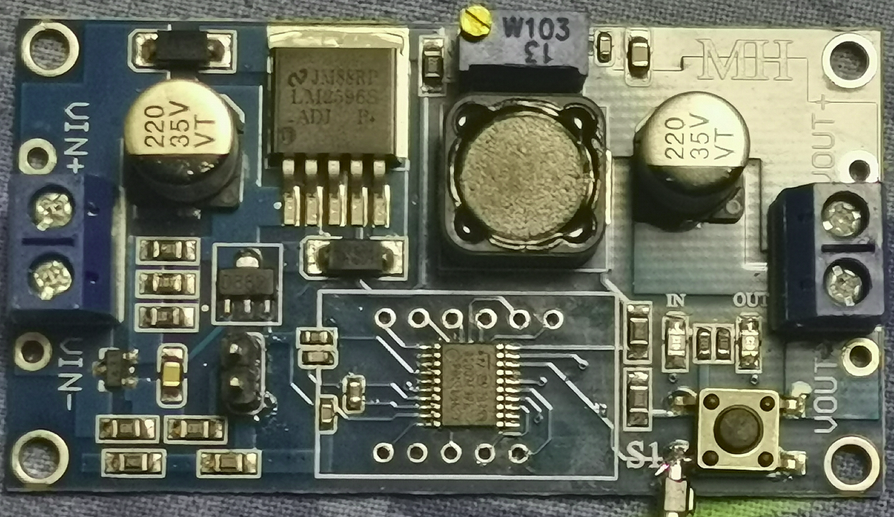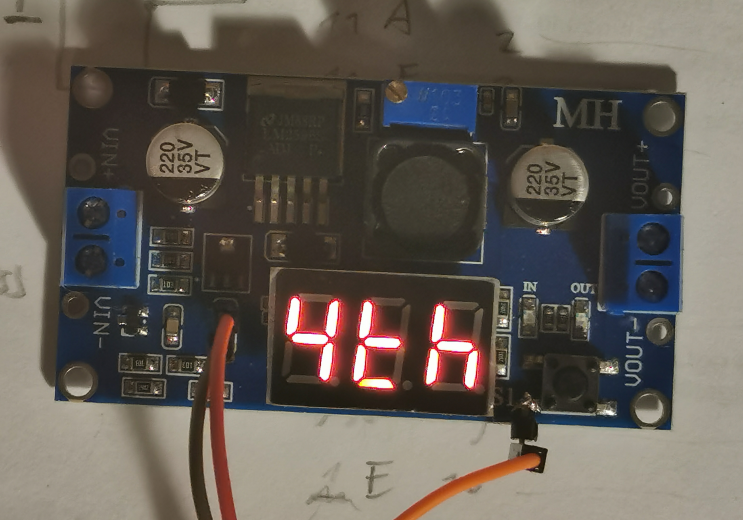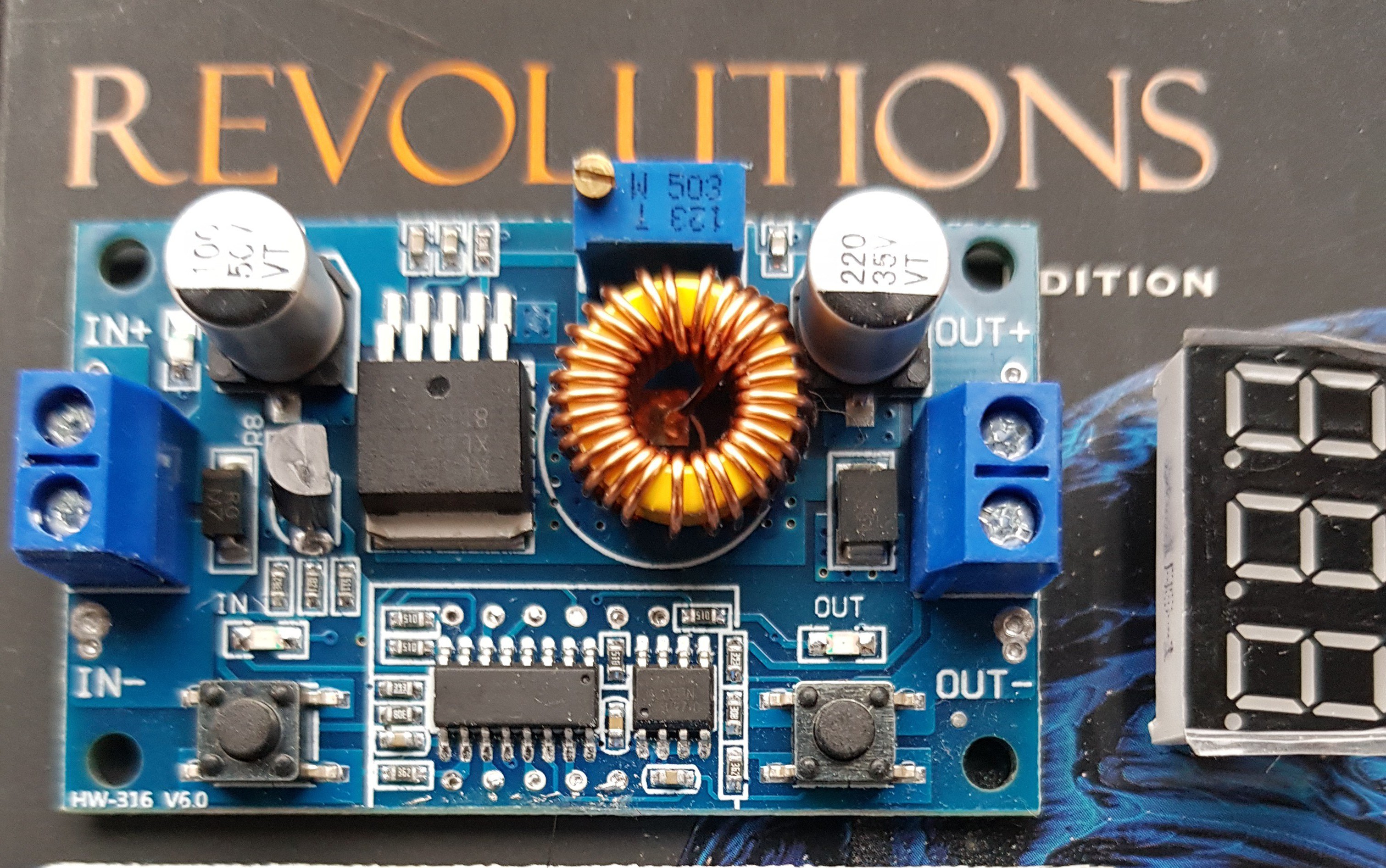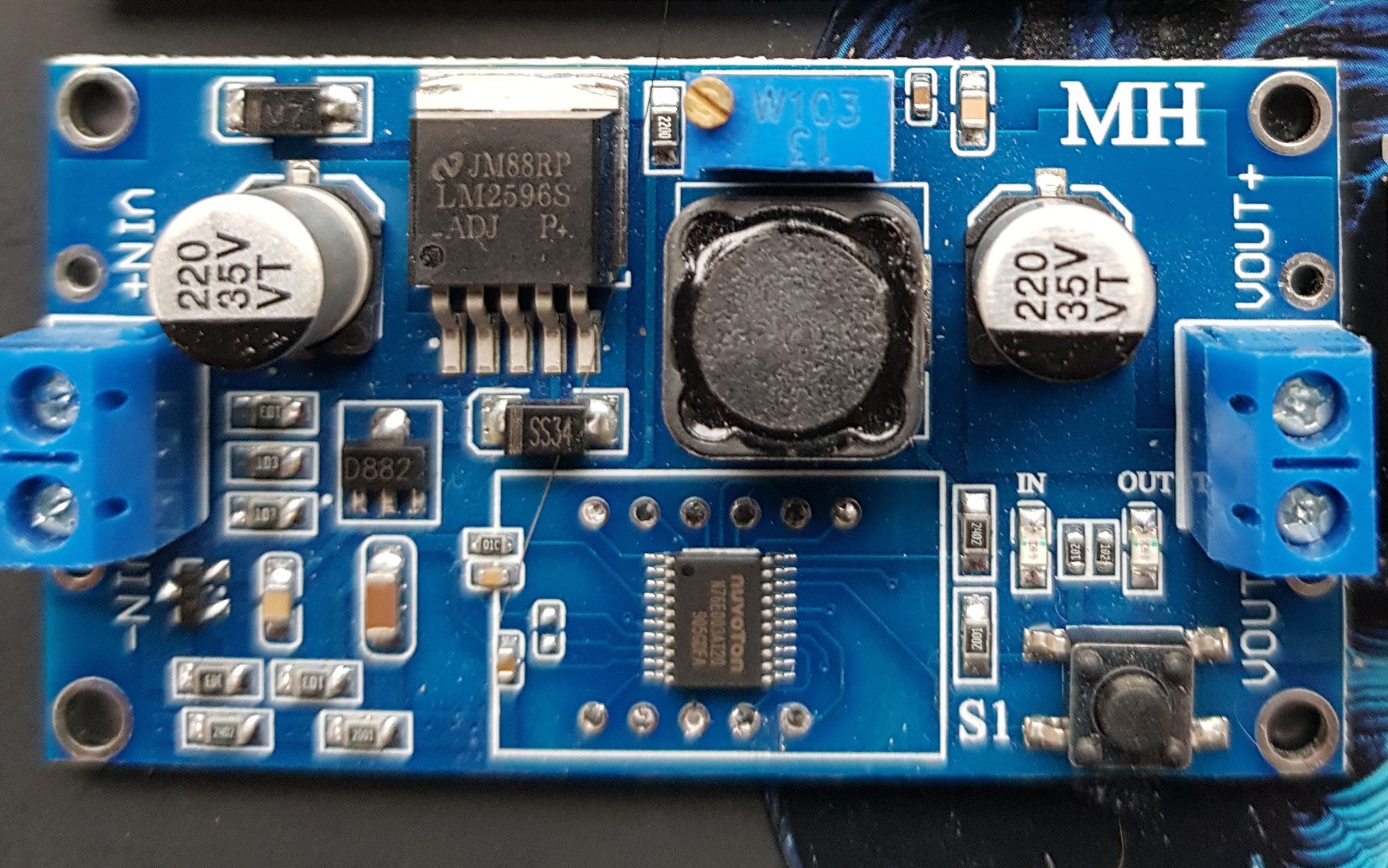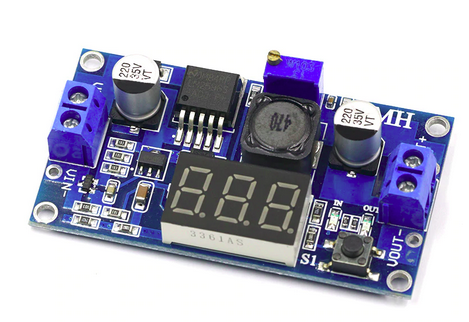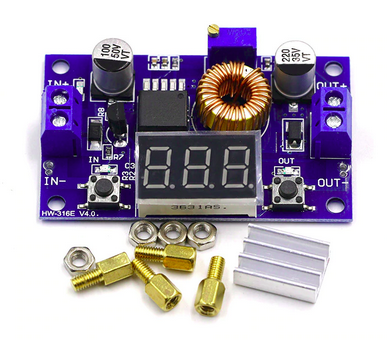-
New boards have arrived
02/01/2020 at 13:36 • 1 commentI ordered some more boards from this shop: they look the same as the one I described in my previous log entries. Spare "D882" transistors and TL431 chips are also at hand.
Now I need to figure out how to decouple the feedback path from ground in a way that's easy to do and that doesn't look to kludgy. I ordered small diamond cutting discs which might be the right tool for this job. Let's see what works best.![]()
Edit: as of October 2020 boards are still available from the same shop above. If you're looking for alternative sources look for a blue board with a single push button, not two. -
DCDC-MH circuit diagram
12/28/2019 at 12:25 • 2 commentsModding a module is easier with a circuit diagram. I made one (instead of knitting):
I'm going to refer to to this diagram when discussing modding options.
-
This linear regulator circuit doesn't look quite right
12/25/2019 at 10:55 • 7 commentsSee Edits below!
If a product claims have an input voltage range of 4.5V to 40V the internal power supply should be somewhat robust. The DC/DC converter discussed in the previous log entry uses the following as a linear regulator circuit for the 3.6V that I measured with my Fluke voltmeter:
I used hints from this write-up to do some simple calculations:
At 40V and a (hypothetical) ambient temperature of 20°C, the TL431 power dissipation is 30% above Absolute Maximum Ratings!
Since the temperature around the TL431 is bound to be closer to 50°C, an upper limit of 25V would be safer of the TL431 is to stay below the damaging junction temperature of 150°C.
On the other hand, if I calculate with 25mA operating current of the µC (including LED display) then the LM317 in a TO92 package used in other "DCDC converters w/ voltmeter" impose even lower limits to the supply voltage (19V×0,025A×160°/W + 50°C = 121°C, datasheet).
This means that the "DCDC-MH" module is a bit more sturdy than the other breeds.Of course, this still doesn't explain why I measured 3.6V instead of the 3.33V that the application note makes me expect (maybe the "generic TL431" is rather "D" instead of "B" grade ;-) ).
The other thing that strikes me is the role of Cx. Doesn't amplify noise transmission from +BATT to +VSS?
The circuit discussed in the write-up mentioned above would be more like this:
Unfortunately I currently don't know how to simulate the transient response of the linear regulator. Maybe someone has a suggestion?
Edit 1:
1. After @Ken Yap pointed out a mistake in my circuit-reading, I corrected calculations and findings. Due to reciprocity of error and effect the results didn't change ;-)
2. Ken proposed that operation without LED current might be outside the operating range of the linear regulator circuit on the DCDC-MH board, and that it hence reaches 3.6V instead of the expected 3.33V. I tested that hypothesis and didn't find any load dependency:
- 3.64V without LED
- 3.64V with LED
- 3.64V LED + 10mA load
- 3.63V LED + 30mA load
- 3.63V LED + 40mA load
Also I killed the D882 (and had to replace it with an 40 year old BC238 from the used parts box but the voltage didn't change).
Note to self: there is a reason why the TL431 and 78L05 style linear regulators have protection circuits!
Edit 2:
@rubypanther thinks that the purpose of the cap in the DCDC-MH circuit is soft-start or reduced transient responses. He might have a point, and it might not be unusual at all: the TI TL431 datasheet proposes a very similar circuit:
Stability and phase reserve of the TL431 seems to be an"interesting" problem for design engineers.
-
The DCDC-MH works (a hack while waiting for Santa)
12/24/2019 at 17:29 • 4 commentsI tried out my new hot-air rework tool - replacing the µC works great!
![]()
I then traced a few signals (a first gist is here: https://gist.github.com/TG9541/666e421f80dfbc6cca5957238175bf08) and used the trusty W1209 binary as a starting point.7S-display, LEDs and key "S1" all work, and PD1/SWIM is used for half duplex console.
Here is the result:
![]()
Edit: gist updated (now including code).
In case someone wants to order a board: this seller seems to have the lowest price. -
That's what you'll get today
12/24/2019 at 13:08 • 0 commentsIt's been a while since I ordered two cheap DC/DC converters - today I removed the LED displays to see if it's hackable.
The second one, the one that looked most promising since the seller's pictures showed ICP pads, turns out to be disappointing:
![]()
First, there are no ICP pads. Second, the voltmeter is controlled by a combination of two chips. The SOIC-8 chip is a 24C02 EEPROM. I've got no idea why they removed the label from SOIC-16 part, but it's not worth bothering since it's unlikely that a µC without EEPROM would be worth hacking.
The second one looks much better: compared to the first specimen the Nuvoton replacement for our trusty hackable STM8S almost looks like a long-lost friend. The guy who made the PCB even was nice enough to keep the option of using an STM8S003F3P6: the unpopulated pads to the left of the µC are for the Vcap capacitor!
![]()
There is more good news: S1 is connected to pin18 - PD1/SWIM. I didn't test it but ut s likey that there is nothing besides the key connected to it. Of course, there is more to figure out before I it's clear that there is still life in hackable DC/DC converters (e.g. a free-ish GPIO with PWM). If someone wants to try it, here is a recent offer for €1.25 / $1.38 (free shipping!)
-
Going Shopping
07/27/2019 at 08:48 • 0 commentsIt's a fact that in the small world of super cheap electronics gadgets the STM8S003F3P6 has been largely superseded by the (more or less) electrically compatible Nuvoton N76E003AT20, an MCS51-style µC.
Chinese manufacturers are moving on. New designs appear, which are maybe easy to hack, maybe not. Replacing an TSSOP20 µC on a PCB isn't difficult, though, and I decided to give two new very cheap boards a try:
![]()
This one is available for $1.27 (incl. shipping); it clearly has a different circuit design than the ones explored so far in the HaD project. Since mo one west of China knows what's under the LED, I ordered one to figure that out. Maybe it's hackable.
Another one uses a more modern DC/DC converter silicon, the XL4015, but otherwise it looks very similar to the old design:
![]()
What's promising is the ISP pads on the backside of the board that show a pattern typical for boards with STM8 µC. I don't really expect one there, but who knows. I've seen it for $1.65 (incl. shipping), and maybe I can hack it to run STM8 eForth.
-
Where to go from here?
10/22/2018 at 19:06 • 0 commentsThis project has been very quiet - to be honest about it I don't even know if the $1.50 modules available today still has a trusty STM8S003F3P6 or rather an incompatible (but a couple of cents cheaper) Nuvoton N76E003AT20 under the LED display. It's true, the STM8S003F3P6 chips are getting cheaper again, but as a buyer of "cheap gadgets" you should now be prepared to do some soldering.
However, STM8 eForth is alive and kicking, and with the code in this project, a $0.85 STM8S103F3P6 breakout board, and a $0.50 LM2596 module a programmable power supply can be built for ver,y little money. In fact, it's possible to control several LM2596 modules with one Forth module - which should be interesting for robustness tests use cases, like the one described here.
-
STM8 eForth 2.2.22-pre2: Improved Robustness of Serial Interface
04/15/2018 at 20:42 • 0 commentsAmong many other things (e.g. EVALUATE and IDLE Operation) the upcoming STM8 eForth 2.2.22 improves the communication robustness of devices that share the GPIO used for communication with the 7S-LED display.
The Wiki has also been improved. Check it out!
-
STM8 eForth 2.2.20 tested with the Low-Cost Programmable Power Supply
12/23/2017 at 22:51 • 0 commentsI just tested one of my green boards with the latest STM8 eForth 2.2.20:
- the improved e4thcom support works great, even though the communication uses the DP segment
- #require loads aliases for unlinked words from the folder out/DCDC/target
- even loading Manfred Mahlow's STM8 eForth VOC extension, which patches the core, works without problems
The packaging method with automated builds (Travis-CI) used in the W1209 data logging thermostat project works well, and I plan to use it for providing pre-build "programmable power supply" binaries.
-
STM8EF v2.2.15: e4thcom 2-wire mode improves DC/DC usabiliy
09/17/2017 at 18:29 • 0 commentsThe latest STM8EF release v2.2.15 contains a CN2596 DC/DC board binary that works great with the latest e4thcom STM8EF plug-in.
Here is a demo (asciinema garbled the console key input a bit):
Please note that the coding examples can now use the e4thcom Forth code #include & #require features. It's also possible to create binaries from the same code using the STM8S simulation feature of uCsim.
Low-Cost Programmable Power Supply
Chinese "LM2596 DC/DC buck converter with voltmeter" + "some wires" + "Forth" = "programmable power supply"
 Thomas
Thomas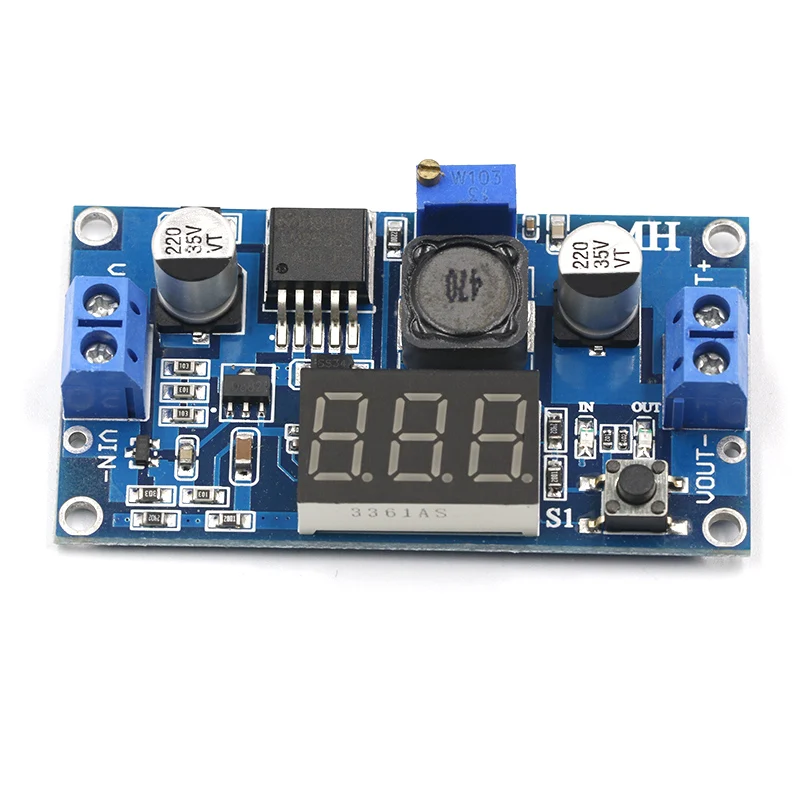
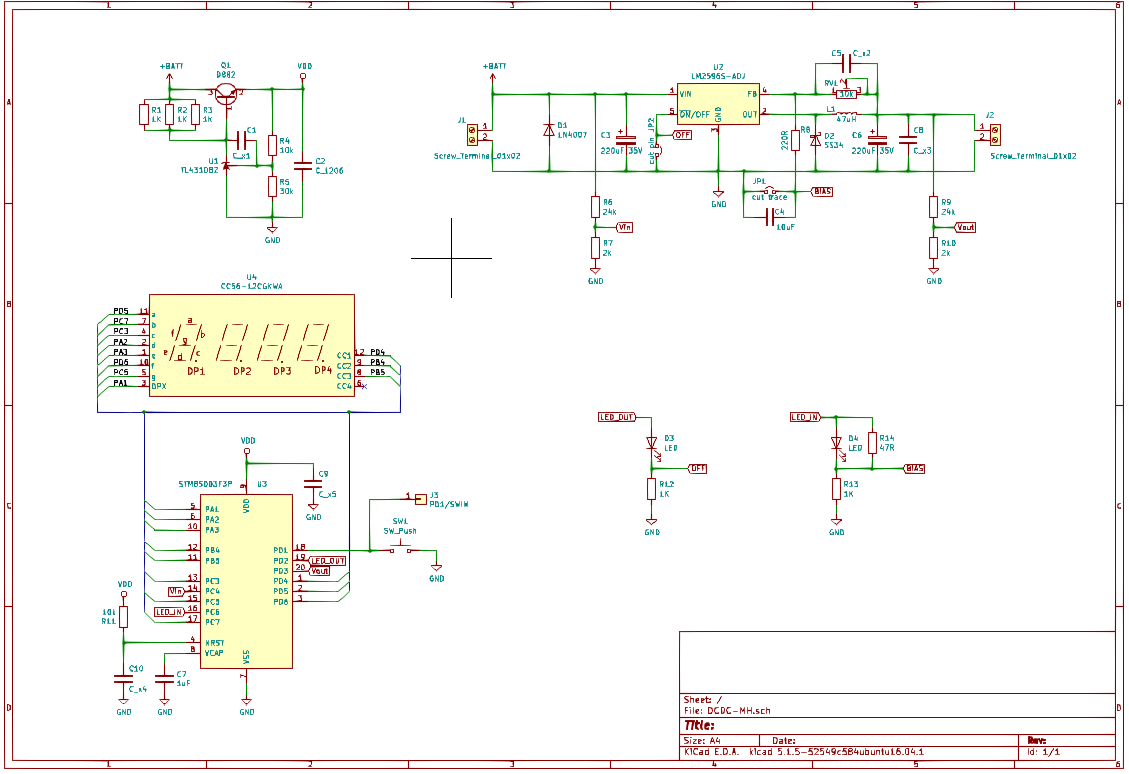 I'm going to refer to to this diagram when discussing modding options.
I'm going to refer to to this diagram when discussing modding options.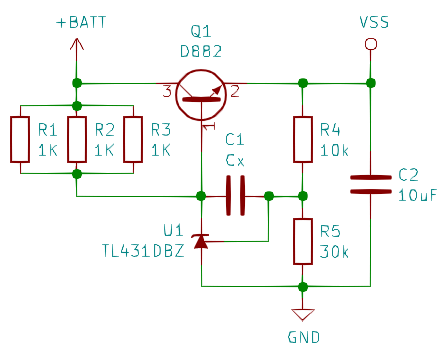
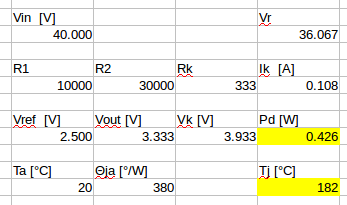 At 40V and a (hypothetical) ambient temperature of 20°C, the TL431 power dissipation is 30% above
At 40V and a (hypothetical) ambient temperature of 20°C, the TL431 power dissipation is 30% above 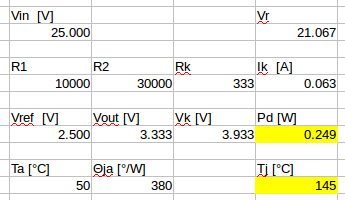 Since the temperature around the TL431 is bound to be closer to 50°C, an upper limit of 25V would be safer of the TL431 is to stay below the damaging junction temperature of 150°C.
Since the temperature around the TL431 is bound to be closer to 50°C, an upper limit of 25V would be safer of the TL431 is to stay below the damaging junction temperature of 150°C.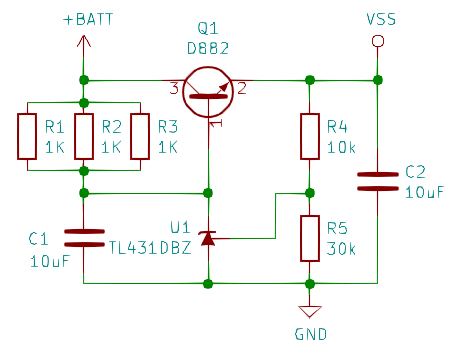
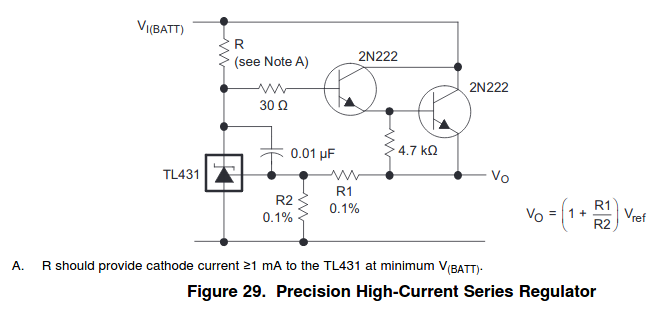 Stability and phase reserve of the TL431 seems to be an
Stability and phase reserve of the TL431 seems to be an